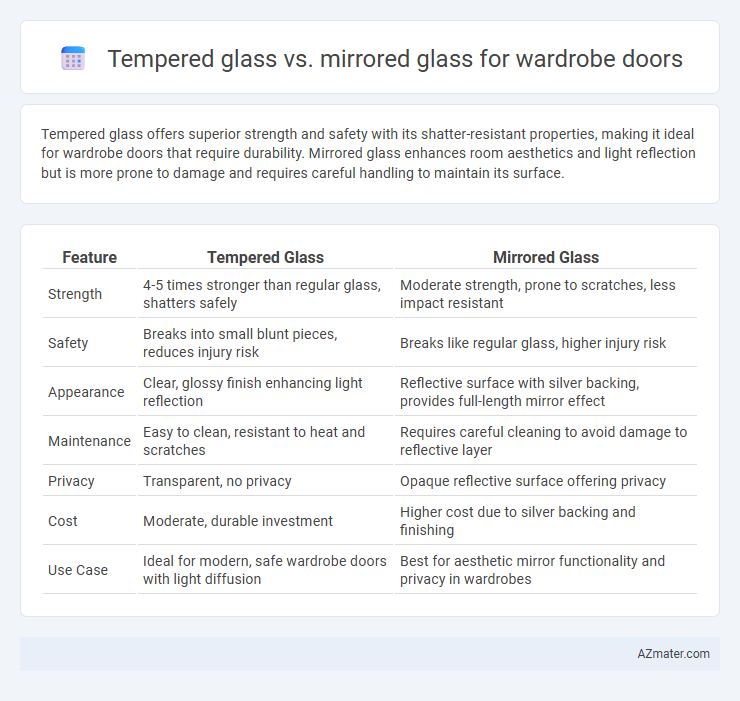Tempered glass offers superior strength and safety with its shatter-resistant properties, making it ideal for wardrobe doors that require durability. Mirrored glass enhances room aesthetics and light reflection but is more prone to damage and requires careful handling to maintain its surface.
Table of Comparison
| Feature | Tempered Glass | Mirrored Glass |
|---|---|---|
| Strength | 4-5 times stronger than regular glass, shatters safely | Moderate strength, prone to scratches, less impact resistant |
| Safety | Breaks into small blunt pieces, reduces injury risk | Breaks like regular glass, higher injury risk |
| Appearance | Clear, glossy finish enhancing light reflection | Reflective surface with silver backing, provides full-length mirror effect |
| Maintenance | Easy to clean, resistant to heat and scratches | Requires careful cleaning to avoid damage to reflective layer |
| Privacy | Transparent, no privacy | Opaque reflective surface offering privacy |
| Cost | Moderate, durable investment | Higher cost due to silver backing and finishing |
| Use Case | Ideal for modern, safe wardrobe doors with light diffusion | Best for aesthetic mirror functionality and privacy in wardrobes |
Introduction to Wardrobe Door Glass Options
Tempered glass offers enhanced strength and safety for wardrobe doors, resisting impact and shattering into small, blunt pieces upon breakage. Mirrored glass provides a functional and aesthetic advantage by reflecting light and creating an illusion of space in bedrooms or dressing areas. Choosing between tempered and mirrored glass depends on priorities like durability, safety, and design preferences for wardrobe doors.
What Is Tempered Glass?
Tempered glass is a type of safety glass processed by controlled thermal or chemical treatments to increase its strength compared to normal glass. It is designed to shatter into small, blunt pieces upon impact, reducing the risk of injury, making it ideal for wardrobe doors where durability and safety are priorities. Unlike mirrored glass, which primarily serves aesthetic and reflective purposes, tempered glass offers enhanced resilience against breakage and scratches.
What Is Mirrored Glass?
Mirrored glass is a type of glass coated with a reflective material, typically silver or aluminum, applied on one side to create a mirror finish that enhances light and space perception in a room. It differs from tempered glass, which is heat-treated for increased strength and safety but does not possess reflective properties. When choosing wardrobe doors, mirrored glass provides aesthetic appeal and functional benefits like room brightening and visual expansion, while tempered glass offers superior durability and impact resistance.
Durability: Tempered vs. Mirrored Glass
Tempered glass offers superior durability for wardrobe doors due to its heat-treated, strengthened structure, making it highly resistant to impact and less prone to shattering compared to mirrored glass. Mirrored glass, while aesthetically appealing, is more fragile and susceptible to cracks and chips upon impact because it lacks the reinforced treatment present in tempered glass. Choosing tempered glass ensures enhanced safety and longevity, ideal for high-traffic bedroom environments.
Safety Considerations
Tempered glass offers superior safety for wardrobe doors due to its ability to shatter into small, blunt pieces upon impact, significantly reducing the risk of injury compared to traditional glass. Mirrored glass, while enhancing aesthetic appeal, can pose a higher risk if not tempered since broken shards are sharp and hazardous. Opting for tempered mirrored glass combines the reflective benefits with enhanced safety, making it the ideal choice for wardrobe doors in homes and commercial spaces.
Aesthetic Appeal and Design Flexibility
Tempered glass wardrobe doors offer a sleek, modern aesthetic with enhanced durability and safety, allowing for a range of frosted, tinted, or clear finishes that complement minimalist and contemporary interiors. Mirrored glass doors provide a reflective surface that visually expands space and increases natural light, ideal for creating a luxurious, elegant atmosphere in bedrooms or dressing areas. Both materials offer distinct design flexibility, with tempered glass excelling in color and texture variation, while mirrored glass enhances spatial perception and decorative sophistication.
Light Reflection and Room Brightness
Tempered glass wardrobe doors offer high transparency and minimal light reflection, allowing natural light to pass through and enhance overall room brightness. Mirrored glass reflects light strongly, creating an illusion of a larger, brighter space by amplifying existing light sources. Choosing tempered glass preserves openness and clarity, while mirrored glass boosts light reflection and adds depth to smaller rooms.
Maintenance and Cleaning Differences
Tempered glass wardrobe doors require minimal maintenance due to their durability and resistance to scratches, making cleaning with a soft cloth and mild glass cleaner highly effective. Mirrored glass doors demand frequent cleaning to prevent visible smudges and fingerprints, often necessitating special glass cleaners to maintain clarity and avoid streaks. Both materials benefit from gentle, non-abrasive cleaning routines, but mirrored glass typically requires more regular attention to preserve its reflective quality.
Cost Comparison
Tempered glass wardrobe doors typically cost more due to their enhanced safety features and durability, with prices ranging from $50 to $100 per square foot. Mirrored glass doors are usually less expensive, averaging between $40 and $70 per square foot, but they may require more maintenance and are prone to visible smudges and cracks. The initial investment in tempered glass can lead to long-term savings because of its resistance to breakage and lower replacement frequency.
Which Glass Type Is Best for Your Wardrobe Door?
Tempered glass offers superior strength and safety, making it ideal for wardrobe doors in households with children or high-traffic areas due to its shatter-resistant properties. Mirrored glass enhances room brightness and creates a spacious feel, but requires more maintenance to avoid visible smudges and scratches. Choosing between tempered and mirrored glass depends on whether safety and durability or aesthetics and light reflection are the priority for your wardrobe door.

Infographic: Tempered glass vs Mirrored glass for Wardrobe door
 azmater.com
azmater.com